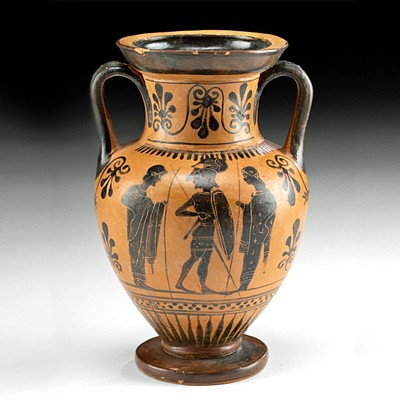18th C. Chinese Qing Gilt Wood Guanyin, Bringer of Sons
Lot 148b
About Seller
Artemis Gallery
686 S Taylor Ave, Ste 106
Louisville, CO 80027
United States
Selling antiquities, ancient and ethnographic art online since 1993, Artemis Gallery specializes in Classical Antiquities (Egyptian, Greek, Roman, Near Eastern), Asian, Pre-Columbian, African / Tribal / Oceanographic art. Our extensive inventory includes pottery, stone, metal, wood, glass and textil...Read more
Categories
Estimate:
$7,000 - $10,500
Absentee vs Live bid
Two ways to bid:
- Leave a max absentee bid and the platform will bid on your behalf up to your maximum bid during the live auction.
- Bid live during the auction and your bids will be submitted real-time to the auctioneer.
Bid Increments
| Price | Bid Increment |
|---|---|
| $0 | $25 |
| $300 | $50 |
| $1,000 | $100 |
| $2,000 | $250 |
| $5,000 | $500 |
| $10,000 | $1,000 |
| $20,000 | $2,500 |
| $50,000 | $5,000 |
| $100,000 | $10,000 |
| $200,000 | $20,000 |
About Auction
By Artemis Gallery
Mar 9, 2023
Set Reminder
2023-03-09 10:00:00
2023-03-09 10:00:00
America/New_York
Bidsquare
Bidsquare : Exceptional Ancient, Ethnographic, & Fine Art
https://www.bidsquare.com/auctions/artemis-gallery/exceptional-ancient-ethnographic-fine-art-12354
Artemis Gallery info@artemisgallery.com
Artemis Gallery info@artemisgallery.com
- Lot Description
**First Time At Auction**
East Asia, China, Qing Dynasty, ca. 18th to 19th century CE. An endearing wooden sculpture of the Bodhisattva Guanyin in her aspect as Songzi Guanyin the Bringer of Sons, holding a male child as she sits atop a double lotus pedestal, adorned with liberal remains of gilding. Posed naturalistically, the deity sits in half lotus position with the child balanced atop her left leg. Her hair is piled atop her head and draped in the hood of a shawl that falls down her shoulders. She gently bows her head, her sweet visage comprised of downcast eyes, a broad nose, and a petite smile. As the most precious treasure in premodern China was a son to carry on the family legacy, during the 15th to 17th centuries a new form of Guanyin emerged known as Songzi that presented the bodhisattva as a bestower of sons. Sculptures of Guanyin cradling the hoped-for baby boy, like this example, would have been made for personal veneration by a wealthy devotee who wished to become a mother. Size: 9.3" W x 21.9" H (23.6 cm x 55.6 cm)
Male children were important to the Confucian family structure since they not only ensured the continuity of family and clan, but that there would be uninterrupted generations to carry on the rituals of ancestral worship. Note the resemblance of this sculpture of Guanyin to those of the Madonna and Child; together they represent the universal compassion of divine maternal figures who inspire the faithful.
Bodhisattvas are among the most compassionate beings in the universe, devoting themselves to saving the suffering and helping others achieve enlightenment and Buddhahood. Traditionally depicted as less austere than Buddhas with graceful postures and elegant garments, a nod to the riches of the Northwestern Chinese Silk Road, this piece is no exception. Bodhisattvas or Guanyin are associated with compassion and mercy - their long ears significant, because they rescue all human beings by hearing their cries for help and the sounds of suffering.
Cf. Metropolitan Museum of Art, accession number 51.15.
Provenance: private Hawaii collection, acquired 2000 to 2010
All items legal to buy/sell under U.S. Statute covering cultural patrimony Code 2600, CHAPTER 14, and are guaranteed to be as described or your money back.
A Certificate of Authenticity will accompany all winning bids.
We ship worldwide and handle all shipping in-house for your convenience.
#177467Surface wear as shown with stable fissures, abrasions, and old insect holes in areas. Chipping to pigments, but otherwise intact with nice remaining detail.Condition
- Shipping Info
-
All shipping is handled in-house for your convenience. Your invoice from Artemis Gallery will include shipping calculation instructions. If in doubt, please inquire BEFORE bidding for estimated shipping costs for individual items.
-
- Buyer's Premium



 EUR
EUR CAD
CAD AUD
AUD GBP
GBP MXN
MXN HKD
HKD CNY
CNY MYR
MYR SEK
SEK SGD
SGD CHF
CHF THB
THB














